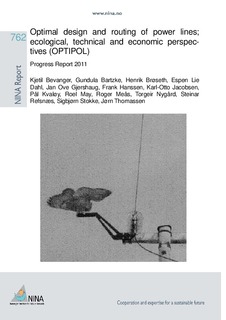| dc.description.abstract | Overall the activities in 2011 have developed satisfactorily and in accordance with the project schedule. The wildlife and power-line corridor subproject is focusing the moose habitat use of the clear-felled area beneath a selected transmission-line section in Bangdalen, Nord-Trøndelag County. Existing data from other NINA projects on moose habitat selection and behavioural re-sponses of linear structures like roads is now included in the project and analysed in a compara-tive approach. Some data sampling still remain, in particular regarding seasonal variations on habitat use along the Bangdalen transmission section. In Ogndalen the data sampling on the ca-percaillie and black grouse population has started and so far the estimate indicate a black grouse and capercaillie density of 1.2 and 0.5 birds per km2 respectively. Patrols along the 7 km long transmission-line section have located a total of 38 bird fatalitiesof which a majority are galli-naceous birds. Due to severe snow melting conditions during the data sampling period in March-April, only one sampling of excrements for DNA analyses could take place. To compensate this loss a final data sampling probably has to take place in spring 2013. The Least Cost Path (LCP) modelling project has chosen the Klæbu-Viklandet transmission line (built in 2002) as a pilot, in agreement with NVE and Statnett, to test the LCP methodology. Subjects and criteria from eco-nomical, technological, ecological and social perspectives are identified by the OPTIPOL/LCP research team, and the work ahead will focus on validating and mapping them. This will be done using a participatory dialog process with the key stakeholders during spring 2012. The first work-shop will take place in February/March 2012. The eagle owl project on Sleneset in Lurøy has, apart from looking at population aspects, also concentrated on mitigating the electrocution haz-ard. Earlier solution to the electrocution problem has focused on e.g. covering the wires in their suspension points. This has, however, resulted in increased corrosion problems. Corrosion of power-line equipment is a major problem in Norway, particularly in coastal areas with a high ma-rine corrosion index. A solution used in the US has been to construct perching structures on the top of the pylons, i.e. above the insulators and the pylon crossarm. In principle this is a good solu-tion, however, in some environments it has some obvious disadvantages as bird excrements left on the pylons may serve as a conductor for electricity and increase the electrocution hazard. Based on combined biological and technological awareness of limitations and options we have now designed a new elevated perch construction in cooperation with Eltjeneste AS. The grid owner at Sleneset, Rødøy-Lurøy Kraftverk, has installed these alternative perching structures at a selection of 12 pylons. At the same time perching avoidance structures (racks of sharp plastic spikes) have been fixed to the crossarm, preventing the eagle owl to rest on the dangerous parts of it. So far the results have been very promising, and the surveillance cameras have confirmed that the eagle owl is using the new perching alternative (see cover photo). | nb_NO |
